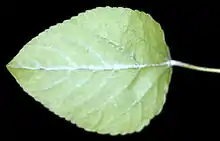Populus heterophylla
Populus heterophylla, also known as downy poplar,[2] swamp poplar[2] and swamp cottonwood,[3] is a large deciduous poplar belonging to the Populus genus of the family Salicaceae. This species can grow on sites that have too much water for other native poplars.[4] On the IUCN Red List this species is listed as "least concern".[5]
| Populus heterophylla | |
|---|---|
 | |
| Scientific classification | |
| Kingdom: | |
| (unranked): | |
| (unranked): | |
| (unranked): | |
| Order: | |
| Family: | |
| Genus: | |
| Species: | P. heterophylla |
| Binomial name | |
| Populus heterophylla | |
 | |
Description
Swamp poplar can reach a height 50 to 100 ft at maturity.[3] The trunk and branches are a light to medium grey, with the trunk being coarsely furrowed.[3] The leaves are alternate deciduous that are 4-6 inches long and 3-4 inches across.[3] Mature leaves are medium to dark green on their upper surface and pale green on the lower surface.[3] Petioles are 2-3 inches long and tend to be between pale green or pale yellow.[3] This species is pollinated by wind.[4] This species flowers in April and fruits May-June.[2]
Habitat
Location
This species is indigenous to warm, temperate regions in North America, although nowhere is it considered abundant. It is found in wet bottomland forests.[4] Swamp cottonwood can be found along the east coast of the United States from Connecticut to Georgia, as well as northwestern Florida and west to Louisiana.[4] It also grows in the Mississippi valley, Ohio and southern Michigan.[4]
Climate
Humid climate is common throughout the range of the swamp poplar.[4] Rainfall varies for this species based on how far north it is found. When found in Indiana the average annual rainfall is about 35 in (890 cm); as opposed to when found in Louisiana average annual rainfall is 59 in (1500 mm).[4] Yearly average temperatures range in the North and South from 50ºF to 70ºF respectively.[4]
Special uses
There are no special uses or commercial value for this species due to the similarity to Populus deltoides, which grows faster and easier.
References
- Smith, K. (2016). "Populus heterophylla". IUCN Red List of Threatened Species. 2016: e.T61959850A61959867. doi:10.2305/IUCN.UK.2016-1.RLTS.T61959850A61959867.en. Retrieved 2 April 2020.
- "Populus heterophylla in Flora of North America @ efloras.org". www.efloras.org. Retrieved 2020-04-23.
- "Swamp Cottonwood (Populus heterophylla)". www.illinoiswildflowers.info. Retrieved 2020-04-23.
- "Populus heterophyfla L". srs.fs.usda.gov. Retrieved 2020-04-23.
- Smith (IUCN), Kevin (2015-04-01). "IUCN Red List of Threatened Species: Populus heterophylla". IUCN Red List of Threatened Species. Retrieved 2020-04-23.

